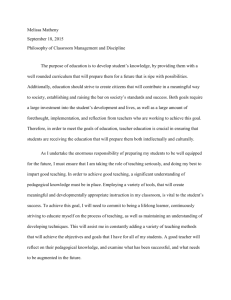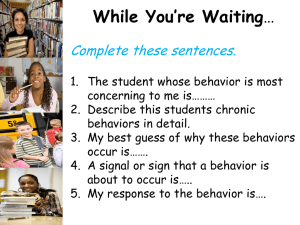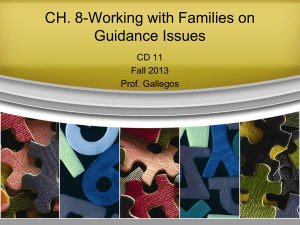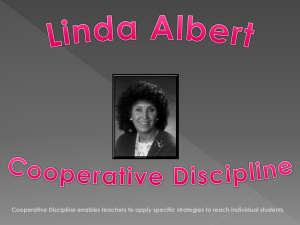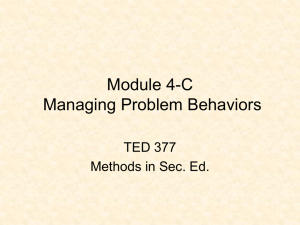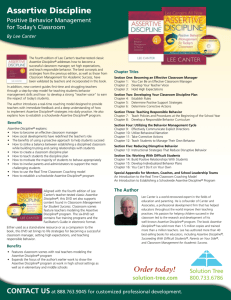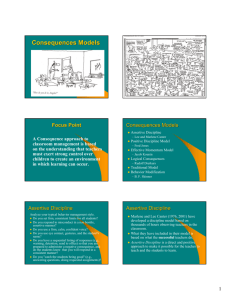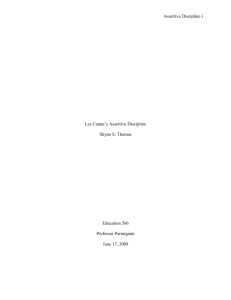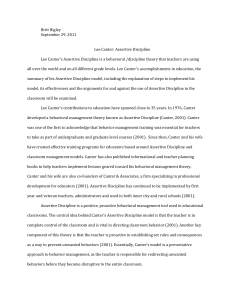Rule Setting Canter, Dreikers
advertisement
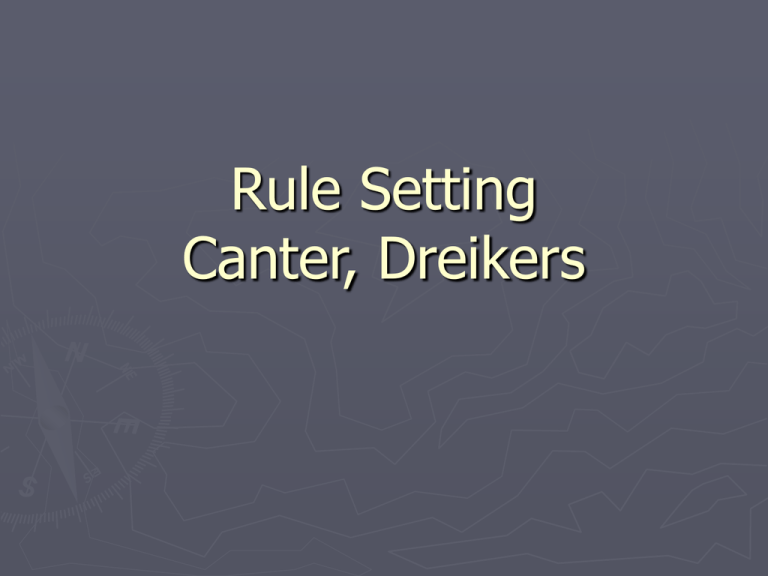
Rule Setting Canter, Dreikers Assertive Discipline ► Lee Canter and Marlene Canter ► Lee: Child guidance specialist ► Marlene: special education teacher ► Goal: to help teachers react to students in a calm, helpful, and consistent manner ► Maintain order so that students may learn ► Respect teachers’ rights Principles ► Students have needs that must be met if they are to be taught effectively ► The most effective teachers are those who remain in control of the classroom ► Principle duty of teachers is to help students learn and behave responsibly ► A good discipline plan is necessary to help students get around their own counterproductive behavior Principles ► Teachers need practice in positive repetitions ► Negative consequences are penalties teachers use when students violate expectations ► Positive consequences are rewards ► Teachers must model and directly teach positive behavior Principles ► Teachers can have success with students deemed difficult-to-manage Assumptions ► Students must be forced to comply with the rules ► Students cannot be expected to determine appropriate classroom rules ► Students cannot be expected to follow the set rules without a system of guidance Assumptions ► Punishment will cause good students to avoid bad behavior and engage in good classroom behavior ► For proper classroom management, parents and administrators must help to enforce rules ► “Whereas behavior modification emphasizes reinforcing appropriate behaviors and ignoring inappropriate ones, assertive discipline emphasizes punishing unacceptable behaviors and providing reinforcement for behaviors that re acceptable to teachers.” C. (2000). Classroom discipline and management. New York: John Wiley. ► Edwards, Misconceptions Canter Would Dispell ► Good teachers should be able to handle discipline problems on their own. ► Firm discipline may cause psychological harm. ► Discipline problems do not persist when children are provided with activities that satisfy their needs. ► Misbehavior has deep seated causes on which teachers have no influence. ► Teachers MUST assert their rights Right to establish classroom rules and procedures Right to insist on behavior from students that meets teachers needs Right to insist on behavior from students that encourages positive social growth and educational development of students Right to receive help in discipline Three types of teachers ► Non assertive ► Hostile ► Assertive Roadblocks to becoming more assertive ► Doubts about ability to deal with students’ behavior problems ► Failure to recognize some children need firmer discipline ► Failure to realize teachers have rights ► Failure to realize students need limits to be set Applying Assertive Discipline ► Six steps Create positive student-teacher relationships Establish rules and expectations Track misbehavior Use punishments to enforce limits Implement a system of positive consequences Establish strong parent suport Rules ► Teachers set the rules ► Post the rules in the classroom ► Specify the behaviors ► Rules should meet teachers’ needs ► Rules should not make unrealistic demands on students Names on the board ► One quick way to track misbehavior At first infraction, put students name on the board On subsequent misbehaviors, put check marks beside names Have consistent punishments for numbers of checks received Names on board is NOT an essential part of the Canters’ system however, they do feel it is a way to track misbehavior without disturbing the class Language ► Proper assertive language ► Four levels Hints: “Everyone should be working.” Questions: “Would you please get to work?” I message: “I want you to open your books and get to work.” Demand: “Get to work now!” Other hints ► Eye contact ► Gestures (but aviod threatening gestures) ► Single out unruly students ► Physical touch Step 4. ► One commonly used punishment is time out ► Withdrawal of privileges ► Detention ► Sent to principal’s office ► Calling parents ► Sent student to another class ► Tape record the offending behavior Step 5. Positive consequences ► Glass jar of marbles for good behavior ► Personal attention from the teacher ► Positive notes to parents ► Awards ► Special privileges ► Material rewards ► Home rewards ► Group rewards Assertive discipline ► Strengths Simple to use Personal desires of teacher can be reinforced Involves parents Involves administrators Assertive discipline ► Weaknesses Names on board mat entice misbehavior Students may be angered by repeated warnings Students may be embarrassed Fails to engender self direction Does not deal with underlying causes Advocates additional suspensions Positive reinforcement is random, tracking misbehavior is systematic Negative consequences stimulate negative behavior Dreikers ► Student of Adler ► Based on “Logical Consequences” ► Give students a choice of behaviors ► Behaviors are driven by an individual’s purpose Assumptions ► Inappropriate behavior is motivated by a need to gain attention, exercise power, exact revenge, or display inadequacy. ► If motive for attention is satisfied, inappropriate behavior associated with other motives will not be manifested. ► Inappropriate behavior can be stopped by finding a legitimate outlet to satisfy needs. Assumptions ► Children can learn to understand own motives. Teachers can help them understand why they misbehave. ► Children will behave more appropriately when they “suffer” consequences. ► Presenting children with a choice between two alternative behaviors give them a chance to learn to be responsible. Motives for behavior ► Gaining attention ► Exercising power ► Exacting revenge ► Displaying inadequacy Gaining attention Active constructive Active destructive tattling; overly cooperative; conform readily, success oriented, perfectionist want their own way, impertinent, defiant, clown around and bully others, pester others Goal: Immediate and continuous Goal: to receive constant praise and attention maintain superiority Passive Constructive Passive Destructive Charm others, manipulative, manipulate by helplessness, vain, cute, sycophant, clinging, selfcentered Bashful, dependent, untidy, selfindulgent, lazy, lack of concentration, claims tasks are too hard, lack of positive action Goal: to get others to serve them Goal: Force others concern, get help from others Exercising power ► Avoid putting pressure on them to succeed because it will become a power struggle. They will win. ► Teachers do not have to shoe children who is the boss. Exacting revenge ► Espouse beliefs that all are ouot to get them ► They have been treated unfairly ► Create proof of the dislike by provoking others to retaliate ► Lash out and hurt others and destroy property ► Causing them more pain will result in their causing more pain for others Displaying inadequacy ► Discouraged ► “wrapped in a cloak of inadequacy” ► Conclude they are not as good as others and give up ► Avoid public display to avoid failure Preventing discipline problems ► Encouragement vs. Praise Focus on effort rather than product Stimulates students to continue trying Encouragement highlights value of learning Praise focuses on level of accomplishment Praise and encouragement ► Praise ► Encouragement Your artwork is excellent ► You got the highest mark on the exam ► You always work quietly without disturbing others ► You are doing a wonderful job on the new dance movements ► ► ► ► ► You really seem to enjoy art. I an tell you worked hard to prepare for your exam It is important to you to do your own work You obviously have been spending a lot of time perfecting these dance movements Logical consequences ► Contrived and applied as necessary to control students’ behaviors ► Although the consequence does not happen naturally, it has a connection to the behavior. ► It is not a punishment. Punishment is connected to the person giving it; not to the behavior. Examples Behavior Logical consequence Student pushes another down the stairs Choice of avoiding this behavior or waiting until the stairs have cleared and then go down them Incomplete or sloppy paper Teacher will read it only when it is cleaned or completed Writing on walls Clean it up or pay the janitor to clean it Writing on or gouging desks Sand and refinishing the desk Fighting at recess Plan for avoiding fights or not going to recess Strengths ► Promotes a sense of autonomy for the students ► Incorporates a preventive approach to discipline ► Helps students learn corrective behavior ► Promotes mutual respect ► Assists teachers to consider causes of behaviors before they take action Weaknesses ► Teachers have trouble determining motives of students ► Students may not admit their real motives ► Difficult to respond in a non-controlling way ► Complex dialogue with students


